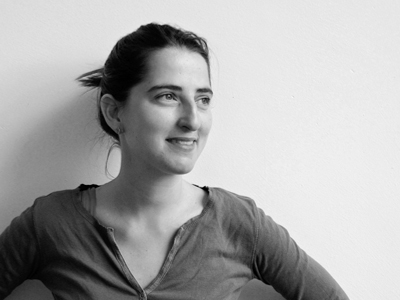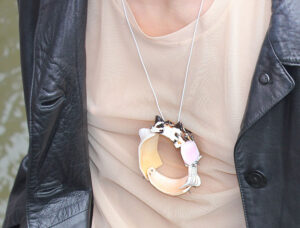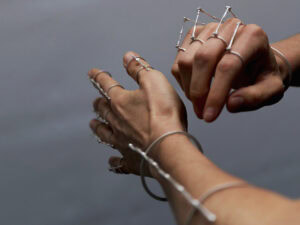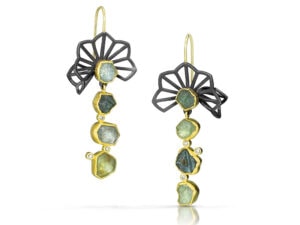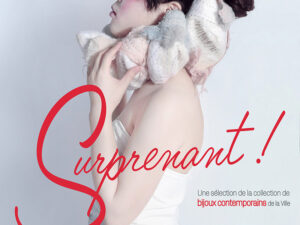“… Greek and Arab coins and gold chains and old jewels brought from the Orient are often discovered in Norway,” writes the Argentinian author Jorge Luis Borges in his essay “The Scandinavian Destiny.”[1] Decades later, the artist Esther Shalev-Gerz (born 1948, Lithuania) visits Borges’s grave in Geneva, only to discover that part of its carvings derive from a Viking-Age runestone placed on the stairwell down to “The Gold Room” at the History Museum in Stockholm.
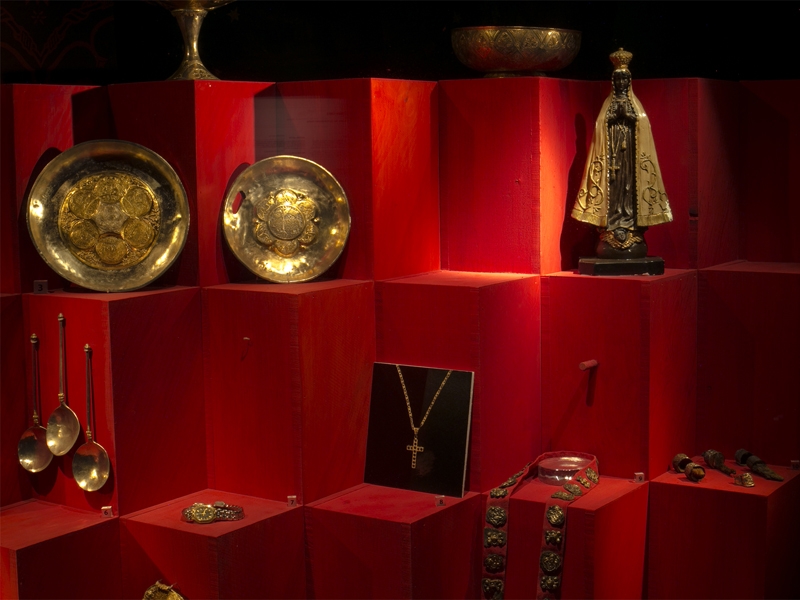
Confusing as it may seem, Shalev-Gerz pulls a red thread through all this with her 40-minute video called “The Gold Room–An Answer to Borges’ Text ‘The Scandinavian Destiny.’” She is one of 10 participant artists who installed work in dialogue with the permanent collection of the museum. In November 2016, the exhibition “History Unfolds” opened its gates following the museum’s tradition of inviting artists to engage with its archives and use history as their point of departure. Apart from the show, the curatorial agenda included an educational program and discussions, as well as an extensive research catalog to further involve a wider audience.
The video work was projected in a small auditorium next to the underground exhibition, which displays archeological finds in gold, silver, and copper from the Migration Period, Viking Age, and Middle Ages. Since the 17th century, a law obliges the state to purchase any unclaimed item made of these metals that dates more than 100 years, resulting in the gathering of a great amount of valuables of diverse origin. Most of them were brought back from far-away expeditions and were melted down to create new hybrid objects blending local and foreign folk traditions.
Inspired by this constellation, Shalev-Gerz invited five historians to unfold potential stories of selected pieces from the archive, and five people who have recently fled their home countries to speak about the objects they chose to bring with them. “In my project you will see objects, those without memory, the ones that are stored in the museum from different places and different periods, and those that are brought here by people that just came here to Sweden and had very little room in their luggage.”[2]
The five portable objects brought by the refugees were a small-scale sculpture, a degree certificate, a golden cross amulet, a golden watch, and a green glass misbaḥa.[3] Explicit personal attachments make these items irreplaceable for each owner, who share their histories through them onscreen. With the exception of the owner of the golden cross, the rest agreed to contribute these objects for the duration of the show–a whole year. After watching the video, one could walk through the main vitrines toward the opposite side of the floor and discover a smaller room with all the items featured in the film, contemporary and old mixed together on little red plinths that match the central exhibition.
The video (below is a different section of video), its execution and staging within the collection, and the display of the actual objects equally supplemented each other, adding more layers in experiencing the work. Avoiding exploitation, Shalev-Gerz gives the stage to the tellers and their narratives for us to reflect on.
Juxtaposing the stories of the refugees with the interpretations of archeologists triggers an alternative reading on the museum artifacts and adornments. Though channels of mobility and object agencies differ much today, the film succeeds in transmitting thoughts that are of relevance now. Examining material culture for archeological purposes reveals how the migration of objects and people had impact on cultures. Among others, trade and war have always put the world in flux, but “it is also apparent that archaeological study focuses on the elite, and that it is their contacts and alliances that drive change. With that narrow perspective on movements in the past, contemporary migration looks like a new phenomenon.”[4]
This is not new knowledge, but the film puts facts in contemporary context, which evokes emotions and challenges prejudices. Investigating physical evidence like the origins of ancient jewelry or war trophies can track us back through the whole of human evolution as well as their psychical moving paths. Listening to personal stories of displacement today provides space for empathy and inclusion–especially if one considers the conditions of emergency under which the refugees selected these objects, and also if one speculates around the circumstances that led some of the, now, museum artifacts to be discovered hidden in the ground.
Urgency brings to surface similar behavioral patterns, which confirm our common human nature. The film documents how people still invest emotion and memories on personal possessions and shows then again how through these objects we seek to mine out shared histories of the past.
Shalev-Gerz answers with her video to Borges, who claimed in his text that although the Nordic people traveled around the world long before any other Europeans, they seemed to not fully understand what they had discovered and remained isolated. Her project statement concludes by proposing a reading of the importance of cultural value Scandinavians saw in the objects they chose to bring back to their homelands, and their connections with different cultures. All these highly sophisticated crafted objects and jewelry are reminders of adventures and personal encounters, but also part of their tradition. Even if this is an additional information to pinpoint, taking in consideration the coincidence of the carvings on Borges’s grave, I am not convinced that this is the most interesting one.

The cultural and emotional value of jewelry sustains through the centuries as an intimate medium to store memories of the present, but also to record possible histories of the past. Unfolding these story tellings next to each other made me further reflect on the purposes that collections of national history museums fulfill. How are they selected? What is shown or hidden? Which stories are told in order to construct national identities and unite collective memories of belonging to a nation? How do these displays craft national histories today, and is there a better universal reading beyond the geographical specifics?
[1] Borges, J., “Selected Non-Fictions,” in Jorge Luis Borges Selected Non-Fictions, eds. E. Weinberger (New York: Viking), 377.
[2] The artist talking about the project: https://www.youtube.com/watch?v=RVyec1BpJrU, visited 1/8/17.
[3] It is worth mentioning that during the creation of Shalev-Gerz’s work, the “Jewellery Law” was enacted Denmark, allowing authorities to confiscate all valuables worth more than 10,000 kroner from asylum seekers, ostensibly to defray the costs of their stay in the country.
[4] Pousette, H. 2017, History Unfolds (Stockholm: Art and Theory Publishing), 164.
